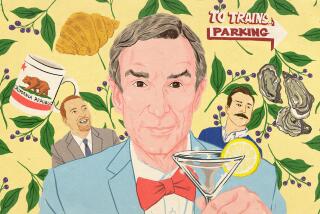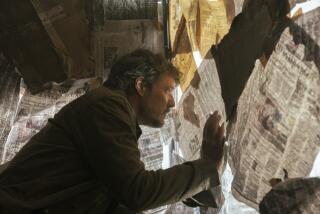All the Elements : SCI-GUYS COME UP WITH SLY WAYS TO TEACH A TRADITIONALLY DRY SUBJECT
- Share via
“Ba-da-bing! Ba-da-bang!” With his trademark end-to-an-explanation, our scientist rushes off on another tangent. Rapid-fire delivery, stand-up hair, neon-green lab coat, high-top sneakers. It’s Beakman the mad scientist zooming his world onto network television for the youngest of the MTV generation. Beakman’s also still on the Learning Channel, where he began collecting his cadres of young scientists last season, when he also ran early Saturday mornings on KTLA.
Beakman is not the first to try to make science accessible to youngsters via the TV screen, and he won’t be the last, but he may well be the wildest, for this or any other season.
Pulling up alongside Beakman territory this season is “Bill Nye the Science Guy,” newly syndicated by Disney. Between Beakman on the Learning Channel every Wednesday night and on CBS Saturday mornings and Bill Nye early Sunday evenings, it’s going to be increasingly difficult for kids to ignore science. And as school districts become hard-pressed for funds, the tube is taking up experimental science education where many school districts must leave off, or can’t even begin.
This season, there are also PBS’ “Newton’s Apple,” with on-location scientific demonstrations; Nickelodeon’s “Mr. Wizard’s World”; and ABC’s animated “Cro,” the Children’s Television Workshop’s first foray into network TV.
Just don’t tell the kids that any of this is, ugh, “educational.” It’s meant to be an entertaining way to teach a sometimes intimidating subject.
“Science education is extraordinarily important, because we don’t do too well in (teaching) science in school,” says Peggy Charren, the highly respected founder of Action for Children’s Television. “We have enough trouble teaching reading and writing, and science is very off-putting, especially to girls. That’s what’s nice about TV shows that feature science in an attractive, fun way.”
“Television can take the audience, and in this case, kids, to a place that they can’t normally get to,” adds William McComas, director of the science education program in the USC Graduate School of Education. “It enables the audience to experience the dangerous, the unseen, and the far away in their living room.”
As did the original “Mr. Wizard” shows for an earlier generation, McComas says, television can confront the discrepancies between what a child thinks is true and the actuality of it--the science.
“The most dominant learning theory right now is ‘constructivism,’ ” McComas says. “Kids have already formed ideas of how things work and it’s the role of the teacher to confront the alternate conception and challenge. Television can do that by showing multiple examples of the way the world really works.”
Beakman, says performance artist Paul Zaloom (who plays the mad scientist), addresses those issues of science that really interest a child. Things that adults might consider, well, disgusting.
“Kids want to know what is snot, what is a fart, why do we burp?” the considerably milder-in-real-life Zaloom, 41, says. “And we explain all this to them.”
In addition to explanations of bodily functions, Beakman also examines how everyday things work, such as lamps and telephones. His zany lab is populated by Lester (Mark Ritts), a lab rat, and the perky Josie (Alanna Ubach). Zaloom says that the sound and special effects crew are invaluable in creating a magical vibe during the scientific demonstrations.
The irreverent Beakman can satisfy nearly anyone’s curiosity with an answer that is always right on, and can be wry, energetic, sarcastic, engaging, funny and loud.
Zaloom notes that the show often responds to letters from kids and tries to answer their questions.
“It’s amazing how much mail we get,” he says. “They want to know everything.”
Nye, a comedian and scientist, is the newest contender on the live-action “science is fun” front. A Cornell grad in mechanical engineering who’s studied astronomy under Carl Sagan, Nye, 37, combines the academic with comedy. He’ll even tell you he once won a Steve Martin look-alike contest in college.
Nye’s show combines the most popular aspects of “Beakman” and “Newton’s Apple,” with its mix of humor and in-the-field action. While the home base of the show is the fictional Nye Laboratories, this science guy doesn’t hesitate to zip over to Mount St. Helens for a show on the earth’s crust or dip into a tub of water to demonstrate buoyancy.
While Nye says he thinks “Beakman” is good show, he is quick to note differences.
“First of all, my show is not exclusively in a lab,” Nye says. “I’ve worked in a lab a lot and a fundamental thing I disagree with is that his (Beakman’s) lab is a mess. That’s not how you keep a real lab. The other thing about him is, like ‘Mr. Wizard’--talk about a guy I worship--he jumps from one thing to another saying, ‘Isn’t this cool?’ Beakman does ‘gee-whiz’ experiments. I have no problem with that, but frankly our show is functionally different in that we have a learning objective and that is discussed throughout the whole show.
Finally, Nye says, “That guy is a performance artist. I’m a real scientist.” The board of advisers for Nye’s show include many high-profile college science educators.
Despite those critiques, Zaloom says, his show, written by real scientists, gets tremendous response. “I used to assume that kids were sitting in front of the TV, zoned-out, and then when I hear them understanding things or repeating concepts back, that’s very gratifying and it’s really cool. It really does happen a lot.”
McComas says of Beakman: “It’s a high-spirited romp through science, rather than the more traditional approach. I have a tendency to agree more with the goal-centered approach of Don Herbert or ‘Newton’s Apple’ or ‘Nova.’ I don’t think science needs to be hyped, because the message may get lost in the medium.”
But, McComas acknowledges, “Clearly one of the ways to see if it’s working, is to see what ideas the kids come in with and discover what they have at the end of such a program.”
This season, kids watching Beakman will learn about bats, tunnels, trains, illusions, pianos, lightning, bones, video games, and ants.
Meanwhile, Nye will look at gravity, digestion, phases of matter, biodiversity, outer space, the eyeball and more.
“TV isn’t a primary teaching machine yet, but it won’t be very long,” Charren predicts, “that Beakman and the Science Guy will be part of the interactive television opportunity. But for right now they’ll just have to supplement the material that must come from the outreach material (schools).”
And there’s nothing stopping kids turned on by one of TV’s science guys to tune in to another, and another, and another.
THE SCIENCE LOG
A selective look at the best of the science shows on TV:
-- Beakman’s World airs Saturdays at 11 a.m. on CBS and Sundays at 4 p.m. and 8:30 p.m. on the Learning Channel.
-- Bill Nye the Science Guy airs Sundays at 5 p.m. on KCAL, Saturdays at 10:30 a.m. on KMIR and 7:30 a.m. on KTTY and Fridays at 8 a.m. on KADY.
-- Cro airs Saturdays at 7 a.m. on KGTV, KEYT, KESQ and at 8 a.m. on KABC.
-- Mr. Wizard’s World airs Saturdays at 6 a.m. on Nickelodeon.
-- Newton’s Apple premieres Nov. 20 at 9:30 a.m. on KCET. It currently airs Wednesdays at 4:30 p.m. on KPBS.
More to Read
The complete guide to home viewing
Get Screen Gab for everything about the TV shows and streaming movies everyone’s talking about.
You may occasionally receive promotional content from the Los Angeles Times.






